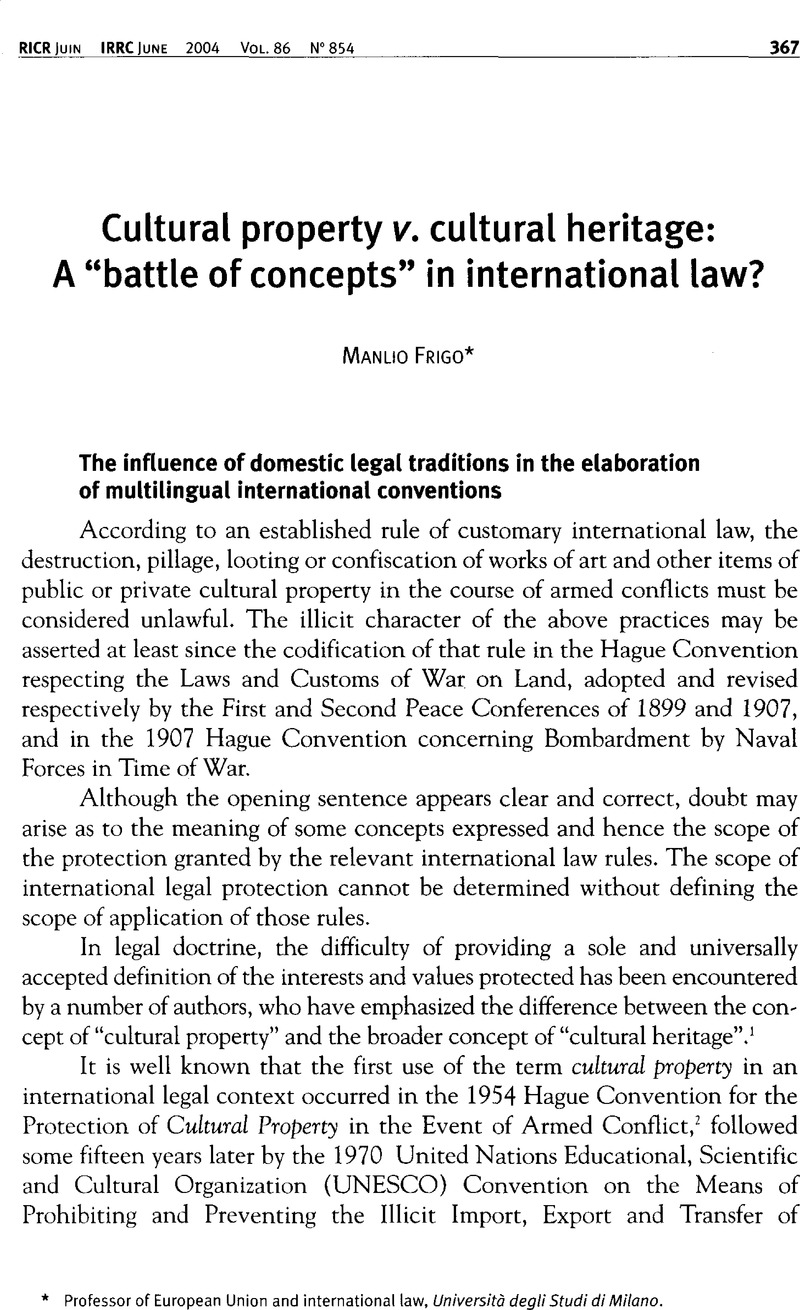Article contents
Cultural property v. cultural heritage: A “battle of concepts” in international law?
Published online by Cambridge University Press: 27 April 2010
Abstract

- Type
- Research Article
- Information
- Copyright
- Copyright © International Committee of the Red Cross 2004
References
1 See Przyborowska-Klimczak, Anna, “Les notions de ‘biens culturels’ et de ‘patrimoine culturel mondial’ dans le droit international”, Polish Yearbook of International Law, Vol. XVIII, 1989–1990, p. 51Google Scholar; Prott, Lyndel and O'Keefe, Patrick J., “‘Cultural heritage’ or ‘cultural property’?”, International Journal of Cultural Property, Vol. 1, 1992, p. 307Google Scholar; O'Keefe, Roger, “The meaning of ‘cultural property’ under the 1954 Hague Convention”, Netherlands International Law Review, Vol. XLVI, 1999, p. 26Google Scholar; Blake, Janet, “On defining the cultural heritage”, International and Comparative Law Quarterly, Vol. 49, 2000, p. 61Google Scholar.
2 Emphasis added.
3 Emphasis added.
4 Emphasis added.
5 Emphasis added.
6 See, for instance, Siehr, Kurt, “The Unidroit Draft Convention on the International Protection of Cultural Property”, International Journal of Cultural Property, Vol. 1, 1992, p. 321Google Scholar; Monaco, Riccardo, “Primo commento della Convenzione di Roma sui beni culturali rubati o illecitamente esportati”, Rivista di studi politici internazionali, Vol. 62, 1995, p. 500Google Scholar; Schneider, Marina, “La Convention Unidroit sur les biens culturels volés ou illicitement exportés”, Nouvelles de l'ICOM, Vol. 49, 1995, p. 18Google Scholar; Loureiro, Vieira, “A proteção internacional dos bens culturais: uma nova perspective”, Revista dos Tribunais, 1995, p. 364Google Scholar; Fraoua, Ridha, “Projet de Convention de l'Unidroit sur le retour international des biens culturels volés ou illicitement exportés”, Aktuelle Juristische Praxis, 1995, p. 317Google Scholar; Lalive, Pierre, “Une avancée du droit international: la Convention de Rome d'Unidroit sur les biens culturels volés ou illicitement exportés”, Revue de droit uniforme. Vol. 1, 1996, p. 40Google Scholar; Frigo, Manlio, «La convenzione dell'Unidroit sui beni culturali rubati o illecitamente esportati», Rivista di diritto internazionale privato e processuale, Vol. 32, 1996, p. 435Google Scholar; Frigo, Manlio, La circolazione internazionale dei beni culturali. Diritto internazionale, diritto comunitario, diritto interno, Giuffré, Milano, 2001.Google Scholar
7 Emphasis added.
8 Emphasis added. See Garabello, Roberta and Scovazzi, Tullio (eds.), The Protection of the Underwater Cultural Heritage: Before and after the 2001 Unesco Convention, Martinus Nijhoff Publishers, Leiden, 2003.Google Scholar
9 Emphasis added.
10 See Blake, op. cit. (note 1), p. 83.
11 See Prott and O'Keefe, op. cit. (note 1), p. 319.
12 See Blake, op. cit. (note 1), p. 67.
13 Treaty on European Community. As it is known the Treaty establishing the European Economic Community was originally signed in Rome on 25 March 1957, entered into force on 1 January 1958 and subsequently amended by the Treaty on the European Union, signed in Maastricht on 7 February 1992 and entered into force on 1 November 1993 – which changed the name of the European Economic Community to simply the European Community – by the Treaty of Amsterdam, signed on 2 October 1997, entered into force on 1 May 1999 – which, inter alia, changed the numbering of the articles of the EC Treaty – and by the Treaty of Nice, signed on 26 February 2001 and entered into force on 1 February 2003.
14 Emphasis added. The German text of Article 30 of the EC Treaty is slightly different, as it refers to “Kulturgu[t] von künstlerischem, geschichtlichem oder archäologischem Wert”.
15 Emphasis added.
16 See, inter alia: Case 29/69, Stauder (1969) ECR 419, para. 3; Case C-219/95, Ferriere Nord v. Commission (1997). ECR I-4411, para. 15; Case C-268/99, Aldona Malgorzata Jany and Oth. v. Staatssecretaris van Justitie (2001), ECR, para. 47.
17 See, inter alia: Case C-449/93, Rockfon (1995), ECR I-4291, para. 28; Case C-236/97, Skatteministeriet v. Codan (1998), ECR I-8679, para. 28; Case C-257/00, Nani Givane v. Secretary of State for the Home Department (2003), ECR, para. 37.
18 See Case 7/68, Commission v. Italy (1968), ECR 562.
19 See Report from the Commission to the Council, the European Parliament and the Economic and Social Committee on the implementation of Council Regulation/EEC) n. 3911/92 on the export of cultural goods and Directive 93/7/EEC on the return of cultural objects unlawfully removed from the territory of a Member State, (hereinafter Report), Brussels, 25.05.2000, COM (2000) 325, p. 3.
20 Ibid.
21 The Annex to Directive 93/7 specifies that “The financial value is that of the object in the requested Member State”.
22 See Report, p. 4.
23 See Article 1 of Regulation 3911/92 and Article 1 of Directive 7/93.
24 See Frigo, Manlio, La protezione dei beni culturali nel diritto internazionale, Giuffré, Milan, 1986, p. 135Google Scholar.
25 Ibid., p. 26.
26 See Council of Europe, Draft Convention on the Protection of the Underwater Cultural Heritage and Explanatory Report, DOC. CAHAQ(85)5, Strasbourg, 23 April 1985 and, for further details, Blake, Janet, “The protection of the underwater cultural heritage”, in International and Comparative Law Quarterly, Vol. 45, 1996, p. 819.CrossRefGoogle Scholar
27 According to Article 1 of the Convention: “(a) ‘Underwater cultural heritage’ means all traces of human existence having a cultural, historical or archaeological character which have been partially or totally under water periodically or continuously, for at least 100 years such as (…)”.
28 See Vittorio Mainetti, “The 2001 UNESCO Convention on the Protection of the Underwater Cultural Heritage: A commentary”, on file with author, p. 23.
29 See Merryman, John Henry, “Two ways of thinking about cultural property”, American Journal of International Law, Vol. 80, 1986, p. 831Google Scholar; Ibid., “The Nation and the Object”, International Journal of Cultural Property, Vol. 3, 1994, p. 61Google Scholar.
30 The preamble to the 1954 Hague Convention refers to the “cultural heritage of mankind/patrimoine culturel de l'humanité”, while the 1972 Paris Convention refers more specifically to the concept of “world heritage of mankind/patrimoine mondial de l'humanité”, raising the question whether the legal regime governing the common heritage of mankind is applicable in our domain. For a negative answer to this, see Frigo, op. cit. (note 24), p. 283.
- 30
- Cited by




